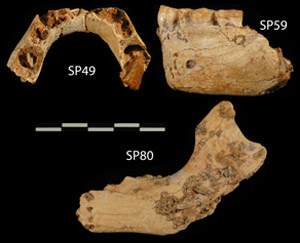It is widely accepted that Upper Paleolithic early modern humans spread westward across Europe about 42,000 years ago, variably displacing and absorbing Neandertal populations in the process. However, Middle Paleolithic assemblages persisted for another 8,000 years in Iberia, presumably made by Neandertals. However, has been unclear whether these late Middle Paleolithic Iberian assemblages were actually made by Neandertals, and what the nature of those humans might have been.

New research, published the week of Dec. 8 in the Proceedings of the National Academy of Sciences, is now shedding some light on what were probably the last Neandertals.
The research is based on a study of human fossils found during the past decade at the Sima de la Palomas, Murcia, Spain by Michael Walker, professor at Universidad de Murcia, and colleagues. It was published by Walker and Erik Trinkaus, Ph.D., the Mary Tileston Hemenway Professor in Arts & Sciences , and colleagues.
The human fossils from the upper levels of the Sima de las Palomas are anatomically clearly Neandertals, and they are now securely dated to 40,000 years ago. They therefore establish the late persistence of Neandertals in this southwestern cul-de-sac of Europe. This reinforces the conclusion that the Neandertals were not merely swept away by advancing modern humans. The behavioral differences between these human groups must have been more subtle than the Middle-to-Upper Paleolithic technological contrasts might imply.
In addition, the Palomas Neandertals variably exhibit a series of modern human features rare or absent in earlier Neandertals. Either they were evolving on their own towards the modern human pattern, or more likely, they had contact with early modern humans around the Pyrenees. If the latter, it implies that the persistence of the Middle Paleolithic in Iberia was a matter of choice, and not cultural retardation.
From the Sima de las Palomas, other late Neandertal sites, and recent discoveries of the earliest modern humans across Europe, a complex picture is emerging of shifting contact between behaviorally similar, if culturally and biologically different, human populations. Researchers are coming to see them all more as people, flexibly making a living through the changing human and natural landscapes of the Late Pleistocene.